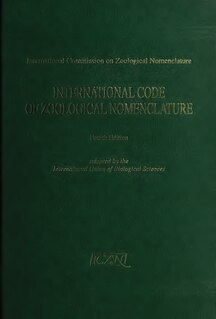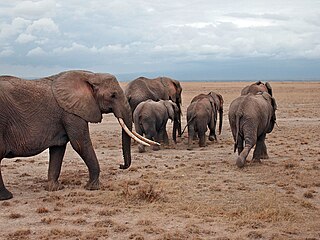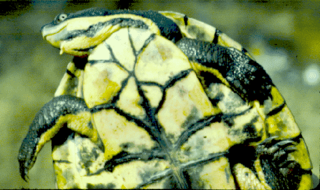
In taxonomy, binomial nomenclature, also called binominal nomenclature or binary nomenclature, is a formal system of naming species of living things by giving each a name composed of two parts, both of which use Latin grammatical forms, although they can be based on words from other languages. Such a name is called a binomial name, a binomen, binominal name or a scientific name; more informally it is also called a Latin name.

The International Code of Zoological Nomenclature (ICZN) is a widely accepted convention in zoology that rules the formal scientific naming of organisms treated as animals. It is also informally known as the ICZN Code, for its publisher, the International Commission on Zoological Nomenclature. The rules principally regulate:

In biology, a taxon is a group of one or more populations of an organism or organisms seen by taxonomists to form a unit. Although neither is required, a taxon is usually known by a particular name and given a particular ranking, especially if and when it is accepted or becomes established. It is very common, however, for taxonomists to remain at odds over what belongs to a taxon and the criteria used for inclusion. If a taxon is given a formal scientific name, its use is then governed by one of the nomenclature codes specifying which scientific name is correct for a particular grouping.

A holotype is a single physical example of an organism, known to have been used when the species was formally described. It is either the single such physical example or one of several such, but explicitly designated as the holotype. Under the International Code of Zoological Nomenclature (ICZN), a holotype is one of several kinds of name-bearing types. In the International Code of Nomenclature for algae, fungi, and plants (ICN) and ICZN, the definitions of types are similar in intent but not identical in terminology or underlying concept.

Dynastinae or rhinoceros beetles are a subfamily of the scarab beetle family (Scarabaeidae). Other common names – some for particular groups of rhinoceros beetles – include Hercules beetles, unicorn beetles or horn beetles. Over 1500 species and 225 genera of rhinoceros beetles are known.
Nomenclature codes or codes of nomenclature are the various rulebooks that govern biological taxonomic nomenclature, each in their own broad field of organisms. To an end-user who only deals with names of species, with some awareness that species are assignable to families, it may not be noticeable that there is more than one code, but beyond this basic level these are rather different in the way they work.
In zoological nomenclature, the valid name of a taxon is the sole correct scientific name. The valid name should be used for that taxon, instead of any other name that may currently be being used, or may previously have been used. A name is valid when, and only when, it is in harmony with all the relevant rules listed in the International Code of Zoological Nomenclature (ICZN). A valid name is the correct zoological name of a taxon.

Crotalus ruber is a venomous pit viper species found in southwestern California in the United States and Baja California in Mexico. Three subspecies are currently recognized, including the nominate subspecies described here.

Cedrela odorata is a commercially important species of tree in the chinaberry family, Meliaceae, commonly known as Spanish cedar or Cuban cedar or cedro in Spanish.
In biological nomenclature, a nomen novum, new replacement name is a scientific name that is created specifically to replace another scientific name, but only when this other name cannot be used for technical, nomenclatural reasons. It does not apply when a name is changed for taxonomic reasons. It is frequently abbreviated, e.g.nomen nov., nom. nov..
The Botanical and Zoological Codes of nomenclature treat the concept of synonymy differently. In botanical nomenclature, a synonym is a scientific name that applies to a taxon that (now) goes by a different scientific name. For example, Linnaeus was the first to give a scientific name to the Norway spruce, which he called Pinus abies. This name is no longer in use, so it is now a synonym of the current scientific name, Picea abies. In zoology, moving a species from one genus to another results in a different binomen, but the name is considered an alternative combination, rather than a synonym. The concept of synonymy in zoology is reserved for two names at the same rank that refer to a taxon at that rank - for example, the name Papilio prorsaLinnaeus, 1758 is a junior synonym of Papilio levanaLinnaeus, 1758, being names for different seasonal forms of the species now referred to as Araschnia levana(Linnaeus, 1758), the map butterfly. However, Araschnia levana is not a synonym of Papilio levana in the taxonomic sense employed by the Zoological code.

Actaeon beetle is a rhinoceros beetle of the family Scarabaeidae.

ZooBank is an open access website intended to be the official International Commission on Zoological Nomenclature (ICZN) registry of zoological nomenclature. Any nomenclatural acts need to be registered with ZooBank to be "officially" recognized by the ICZN Code of Nomenclature.

The Myuchelys is a genus of turtles, the Australian saw-shelled turtles, in the family Chelidae and subfamily Chelodininae. They inhabit the headwaters and tributaries of rivers within their range and this led to the name Myuchelys, which is formed from the Aboriginal word myuna meaning clear water and the Greek chelys meaning turtle. They have a short neck and the intergular scute completely separates the gular scutes. They have no alveolar ridge separating them from the snapping turtles of the genus Elseya.

Megasoma is a genus of rhinoceros beetles. Commonly known as the elephant beetles, Megasoma species are found from the southern half of North America to most of South America.

Megasoma gyas is a species of large Neotropical rhinoceros beetles. There are no recognized subspecies.
Megasoma punctulatum is a species of rhinoceros beetle in the family Scarabaeidae.
Megasoma vogti, known generally as the Texas elephant beetle or Texas megasoma, is a species of rhinoceros beetle in the family Scarabaeidae.
Megasoma sleeperi is a species of rhinoceros beetle in the family Scarabaeidae. It is endemic to the Algodones Dunes in North America.











